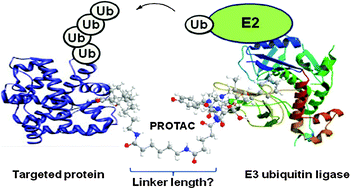Impact of linker length on the activity of PROTACs†
Abstract
Conventional genetic approaches have provided a powerful tool in the study of

* Corresponding authors
a
Department of Pharmaceutical Sciences, University of Kentucky, Lexington, Kentucky, USA
E-mail:
kbkim2@uky.edu
Fax: +1 859 257 7564
Tel: +1 859 257 5301
b Department of Molecular and Biomedical Pharmacology, University of Kentucky, Lexington, Kentucky, USA
Conventional genetic approaches have provided a powerful tool in the study of

 Please wait while we load your content...
Something went wrong. Try again?
Please wait while we load your content...
Something went wrong. Try again?
K. Cyrus, M. Wehenkel, E. Choi, H. Han, H. Lee, H. Swanson and K. Kim, Mol. BioSyst., 2011, 7, 359 DOI: 10.1039/C0MB00074D
To request permission to reproduce material from this article, please go to the Copyright Clearance Center request page.
If you are an author contributing to an RSC publication, you do not need to request permission provided correct acknowledgement is given.
If you are the author of this article, you do not need to request permission to reproduce figures and diagrams provided correct acknowledgement is given. If you want to reproduce the whole article in a third-party publication (excluding your thesis/dissertation for which permission is not required) please go to the Copyright Clearance Center request page.
Read more about how to correctly acknowledge RSC content.
 Fetching data from CrossRef.
Fetching data from CrossRef.
This may take some time to load.
Loading related content
